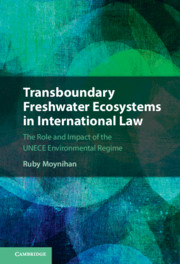 Transboundary Freshwater Ecosystems in International Law
Transboundary Freshwater Ecosystems in International Law Published online by Cambridge University Press: 01 October 2021
This chapter provides an understanding of where international law is at (including customary international law, treaty and case law) in terms of its achievements and shortcomings regarding cooperation over environmental protection and use of transboundary freshwater ecosystems. This work provides a basis for critical analysis over the proceeding book chapters, in relation to the value added by the UNECE. The chapter lays the foundations for determining the UNECE regime’s relationship to international water law, international environmental law and general international law. It explores the role of international courts and the international law commission in interpreting outdated water treaties and bringing their standards of environmental protection closer to contemporary scientific understandings and the more progressive multilateral environmental agreements in accordance with the principle of systemic integration. It also explores instances where Courts have arguably has not gone far enough, leaving gaps in understanding. Unlike Courts, pan-regional or basin treaties and their river basin commissions can develop and interpret rules and principles of international water law on a continual and comprehensive basis and provide the institutional framework which supports implementation and compliance with international water law. This hypothesis, on the added value of the UNECE water regime, is tested over the proceeding chapters.
To save this book to your Kindle, first ensure [email protected] is added to your Approved Personal Document E-mail List under your Personal Document Settings on the Manage Your Content and Devices page of your Amazon account. Then enter the ‘name’ part of your Kindle email address below. Find out more about saving to your Kindle.
Note you can select to save to either the @free.kindle.com or @kindle.com variations. ‘@free.kindle.com’ emails are free but can only be saved to your device when it is connected to wi-fi. ‘@kindle.com’ emails can be delivered even when you are not connected to wi-fi, but note that service fees apply.
Find out more about the Kindle Personal Document Service.
To save content items to your account, please confirm that you agree to abide by our usage policies. If this is the first time you use this feature, you will be asked to authorise Cambridge Core to connect with your account. Find out more about saving content to Dropbox.
To save content items to your account, please confirm that you agree to abide by our usage policies. If this is the first time you use this feature, you will be asked to authorise Cambridge Core to connect with your account. Find out more about saving content to Google Drive.